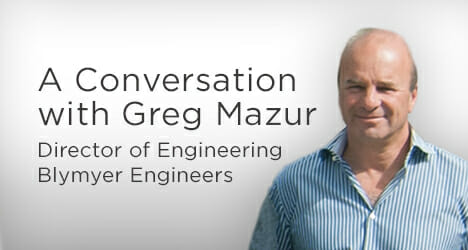Working with EPCs — End-to-End Renewable Energy Engineering Learn More
A conversation with Greg Mazur, Director of Engineering

Q: How did Blymyer Engineers get its start in solar energy, and what was the industry like at the time?
Greg: We started working on small commercial projects in the 20 kW to 50 kW range in 2001.
In 2004, we finished our first design/build project with BEI Construction in Borrego Springs, California, with World Water as the developer. It was a 265 kW fixed-tilt system in the desert, a big solar project for that time.
The photovoltaic modules we used for that project, which were the same 60-cell modules we use now, produced 175 kW of power. Today, those 60-cell modules produce 260 kW of power, about 50 percent more. It shows how much technology has evolved since then. With the same exact real estate, you can produce 1.5 times as much power.
Q: What were the company’s next moves after the Borrego Springs project?
Greg: Borrego Springs was really a breakthrough for us. After that, we started to design large commercial projects—rooftop systems, ground-mount systems. In 2005, we began working with Chevron, which had just formed Chevron Energy Solutions. Together, we developed the first pre-approved design of solar parking canopies for the California Division of the State Architect (DSA).
Solar engineering was in its beginning stages. When we designed the first solar canopies, there was very little to reference in the International Building Code (IBC). We managed to succeed even though our first design was very expensive due to strict DSA regulations and their conservativism.
Since 2006, Blymyer Engineers has designed almost 400 school sites throughout the state of California.
The solar business had grown up quite a bit by 2007 and 2008. During that time we worked on over 300 designs for utility-scale projects, though none of these projects were ever built. However, by 2009, things began to change and projects were being developed. Among the first for us were the Sacramento Municipal Utility District (SMUD) projects, with Recurrent Energy as the developer. All of these SMUD projects were eventually acquired by Google.
Q: What changes have you seen in the last 15 years?
Greg: The NEC and IBC started catching up with the demand. A good example is aluminum conductors. At first, only copper conductors were used in solar projects. No one ever thought that aluminum conductors would be allowed by the regulatory agencies. But the updated codes now allowed for aluminum conductors, which were much cheaper, so installation costs went down.
One of the first commercial projects Blymyer Engineers completed was for Diablo Valley College in Contra Costa, California. In 2006, the cost of the project was about $8 per watt. Solar modules at the time cost $4 per watt. Now, utility-scale projects cost about $1 per watt, with solar modules only costing about 50 cents per watt. It’s been a dramatic change.
Another dramatic change involves inverter units. Where the maximum units were once 250 kW, now they’re 2 MW or more.
DC voltage is another important area of change. Initially, the code allowed DC voltage of 600 volts. But in the last few years, that number jumped to 1,000 volts, and then again to 1,500 volts.
Also, the codes now allow for the direct burial of cables, which contributes as well to cost reduction.
Q: What do you see as the next big thing in solar?
Greg: It has to be battery storage. The big picture is that, in the United States and elsewhere, the amount of solar power being produced is now large enough to overwhelm the grid.
Battery storage is in its beginning stages of development. Technology will catch up, but it’s just not there yet. People are also looking beyond the battery to alternative storage options.
Q: What improvements do you see in solar technology?
Greg: We’re using the same concept for solar production that we were using 15 to 20 years ago. This concept of utilizing silicon to produce power through exposure to the sun was developed by NASA for satellite technology. It has improved since then—density is better, silicon is better— but the basics are the same. However, to produce power this way, you have to have real estate. So the future is in concentrated solar power.
Q: To wrap up, tell us something about your work that inspires you.
Greg: I was born and raised in Odessa in Ukraine. I left Ukraine 30 years ago to come to the United States. I’ve been with Blymyer Engineers since 1997. I love living in San Francisco, but I also wanted to stay connected to my home city. So I encouraged Blymyer Engineers to open an office in Odessa 10 years ago. I’m really happy to help my home city with jobs while helping my company grow and prosper as well.